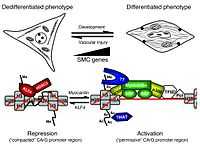Gene transcriptions/Boxes/CArG
< Gene transcriptions < Boxes
CArG boxes are present in the promoters of smooth muscle cell genes.
Consensus sequences
"CArG box [CC(A/T)6GG] DNA [consensus] sequences present within the promoters of SMC genes play a pivotal role in controlling their transcription".[1]
Smooth muscle cells
"Serum response factor (SRF) controls [smooth muscle cell] SMC gene transcription via binding to CArG box DNA sequences found within genes that exhibit SMC-restricted expression."[1]
"SMC genes examined in this study display SMC-specific histone modifications at the 5′-CArG boxes."[1]
"The SRF-CArG association is required for transcriptional activation of SMC genes [...] the SMC genes examined in this study display SMC-specific histone modifications at the 5′-CArG boxes. [...] enrichment of H4 and H3 acetylation [...] were relatively low from positions –2,800 to –1,600 in the 5′ region. However, at position –1,600 to –1,200, there was a sharp rise in these modifications, which was increased even further at +400 in the coding region. We observed similar patterns for H3K4dMe and H3 Lys79 di-methylation [...]. SRF, TFIID, and RNA polymerase II displayed enrichments that were consistent with the positions of the CArG boxes, TATA box, and coding region, respectively".[1]
The CArG boxes occur between -400 and -200 nts, between the E boxes and the TCE element.[1]
Gene transcriptions
"SMC-restricted binding of SRF to murine SMC gene CArG box chromatin is associated with patterns of posttranslational histone modifications within this chromatin that are specific to the SMC lineage in culture and in vivo, including methylation and acetylation to histone H3 and H4 residues."[1]
Myocardins
The "promyogenic SRF [SRF GeneID: 6722] coactivator myocardin [MYOCD GeneID: 93649] increased SRF association with methylated histones and CArG box chromatin during activation of SMC gene expression. [...] myocardin/SRF complexes physically interact with H3K4dMe and that the interaction of SRF with CArG box chromatin and H3K4dMe is sensitive to expression levels of myocardin."[1]
Kruppel-like factor 4
The "myogenic repressor Kruppel-like factor 4 recruited histone H4 deacetylase activity to SMC genes and blocked SRF association with methylated histones and CArG box chromatin during repression of SMC gene expression. [...] deacetylation of histone H4 coupled with loss of SRF binding during suppression of SMC differentiation in response to vascular injury. [...] KLF4 can bind to evolutionarily conserved TGF-β [control element] (TCE) DNA sequences adjacent to CArG boxes of SM gene promoters"[1]
Epigenomes
"SMC-selective epigenetic control of SRF binding to chromatin plays a key role in regulation of SMC gene expression in response to pathophysiological stimuli in vivo."[1]
Histone modifications in SMCs include H3K4dMe, H3 Lys79 di-methylation, H3 Lys9 acetylation, H4Ac, and SRF binding.[1]
Research
Hypothesis:
- A1BG is not transcribed using a CArG box.
Control groups

The findings demonstrate a statistically systematic change from the status quo or the control group.
“In the design of experiments, treatments [or special properties or characteristics] are applied to [or observed in] experimental units in the treatment group(s).[2] In comparative experiments, members of the complementary group, the control group, receive either no treatment or a standard treatment.[3]"[4]
Proof of concept
Def. a “short and/or incomplete realization of a certain method or idea to demonstrate its feasibility"[5] is called a proof of concept.
Def. evidence that demonstrates that a concept is possible is called proof of concept.
The proof-of-concept structure consists of
- background,
- procedures,
- findings, and
- interpretation.[6]
See also
- CAAT boxes
- C/D boxes
- CGCG boxes
References
- 1 2 3 4 5 6 7 8 9 10 Oliver G. McDonald, Brian R. Wamhoff, Mark H. Hoofnagle, and Gary K. Owens (January 4, 2006). "Control of SRF binding to CArG box chromatin regulates smooth muscle gene expression in vivo". The Journal of Clinical Investigation 116 (1): 36-48. http://www.ncbi.nlm.nih.gov/pmc/articles/PMC1323266/. Retrieved 2014-06-05.
- ↑ Klaus Hinkelmann, Oscar Kempthorne (2008). Design and Analysis of Experiments, Volume I: Introduction to Experimental Design (2nd ed.). Wiley. ISBN 978-0-471-72756-9. http://books.google.com/?id=T3wWj2kVYZgC&printsec=frontcover.
- ↑ R. A. Bailey (2008). Design of comparative experiments. Cambridge University Press. ISBN 978-0-521-68357-9. http://www.cambridge.org/uk/catalogue/catalogue.asp?isbn=9780521683579.
- ↑ "Treatment and control groups, In: Wikipedia". San Francisco, California: Wikimedia Foundation, Inc. May 18, 2012. Retrieved 2012-05-31.
- ↑ "proof of concept, In: Wiktionary". San Francisco, California: Wikimedia Foundation, Inc. November 10, 2012. Retrieved 2013-01-13.
- ↑ Ginger Lehrman and Ian B Hogue, Sarah Palmer, Cheryl Jennings, Celsa A Spina, Ann Wiegand, Alan L Landay, Robert W Coombs, Douglas D Richman, John W Mellors, John M Coffin, Ronald J Bosch, David M Margolis (August 13, 2005). "Depletion of latent HIV-1 infection in vivo: a proof-of-concept study". Lancet 366 (9485): 549-55. doi:10.1016/S0140-6736(05)67098-5. http://www.ncbi.nlm.nih.gov/pmc/articles/PMC1894952/. Retrieved 2012-05-09.
External links
- African Journals Online
- Bing Advanced search
- GenomeNet KEGG database
- Google Books
- Google scholar Advanced Scholar Search
- Home - Gene - NCBI
- JSTOR
- Lycos search
- NCBI All Databases Search
- NCBI Site Search
- Office of Scientific & Technical Information
- PubChem Public Chemical Database
- Questia - The Online Library of Books and Journals
- SAGE journals online
- Scirus for scientific information only advanced search
- SpringerLink
- Taylor & Francis Online
- WikiDoc The Living Textbook of Medicine
- Wiley Online Library Advanced Search
- Yahoo Advanced Web Search